Language Development and Enjoyment of Reading: Impacts of Early Parent-Child Activities in Two Growing up in Scotland Cohorts
Language development and enjoyment of reading: impacts of early parent-child activities in two Growing Up in Scotland cohorts.
Chapter 4: Comparing Participation in Home Learning Activities Across the Two Cohorts
4.1 Introduction
Encouraging parents to undertake home learning activities with their child from an early age has long been high on the agenda for both policy makers and academics interested in children's outcomes and development. This chapter sets out the frequency of early home learning activities undertaken by parents and children in each cohort when the children were aged 10 months and 3 years old and how this varies by socio-economic characteristics. The focus is on exploring whether children in BC2 were more likely to experience these sorts of activities than children in BC1. Changes in reading frequency as children got older are also explored for each cohort and between cohorts, with variations by socio-economic circumstances shown. The chapter also outlines who children did activities with at age 3, again including whether there were any differences between the two cohorts. Further to this, the chapter looks at whether the frequency of participating in home learning activities (at both 10 months and 3 years) is related to vocabulary score at age 3.
4.2 Key findings
- At the time they were aged 10 months, children in BC2 (69%) were slightly more likely than children in BC1 (66%) to be read to or to be looking at books most days, whilst they were slightly less likely to sing every day or most days (88% in BC2 compared with 90% in BC1).
- The overall frequency of home learning activities undertaken with the children when they were aged 3 did not differ between the cohorts. However, children who were aged 3 in 2013 (59%) were slightly more likely than children aged 3 in 2007/08 (56%) to have played at recognising letters, words, numbers or shapes 'most days' in the last week in the last week.
- In both cohorts, children living in advantaged circumstances were more likely to undertake frequent home learning activities than children living in less advantaged circumstances. Overall, this relationship was similar across the two cohorts.
- Amongst parents who read with their child once a week or less when the child was aged 10 months, almost nine out of ten had increased the frequency at which they read with their child by the time the child was aged 3. Parents in BC2 were slightly less likely to increase their frequency of reading than parents in BC1.
- Children aged 3 in 2013 were more likely than children aged 3 in 2007/08 to be doing activities both by themselves, with their mother, and with their father.
- In both cohorts, undertaking frequent home learning activities was positively associated with higher vocabulary scores at age 3. No evidence was found to suggest that this association had changed between the cohorts.
- The positive relationship between participating in frequent home learning activities and increased vocabulary scores applied equally to children whose parents had high levels of education and those who had no formal qualifications. This applied across both cohorts.
4.3 Home learning activities at 10 months and age 3
When the cohort children were 10 months old, parents were asked how often they or their partner looked at books or read stories and recited nursery rhymes or sang songs with the child. Answer categories ranged from 'Every day/most days' to 'Never'. At age 3, the questions varied slightly - parents were asked on how many days in the last week the child did one of four activities. For each activity the child had done, parents were then asked who the child did the activity with. [12] The four activities were:
- Looking at books or reading stories
- Singing songs or reciting nursery rhymes
- Drawing or painting
- Playing at recognising letters, words, numbers or shapes
Throughout this chapter, when reference is made to an activity at age 3 being done 'frequently', or 'most days' this is defined as having done the activity on at least four days in the last week.
4.3.1 Home learning activities at 10 months
As shown in previous findings from GUS (Bradshaw et al., 2013) in both 2005/06 and in 2011 the majority of 10-month-old children living in Scotland frequently engaged in activities such as looking at books and reading stories, or reciting nursery rhymes and singing. Table 4.1 shows that around two thirds of children, in both cohorts, read or looked at books most days, while almost everyone recited nursery rhymes or sang songs most days. Around one in five children (21% in both cohorts) were read to or looked at books once or twice a week, while just under one in ten sang songs once or twice a week ( BC1 7%, BC2 9%).
Table 4.1 Frequency of activities at 10 months, by cohort
| BC1 | BC2 | |
|---|---|---|
| % | % | |
| Reading or looking at books | ||
| Most days | 66 | 69 |
| A few days a week | 21 | 21 |
| Less often | 13 | 10 |
| Unweighted bases | 5216 | 6126 |
| Singing songs or reciting nursery rhymes | ||
| Most days | 90 | 88 |
| A few days a week | 7 | 9 |
| Less often | 3 | 3 |
| Unweighted bases | 5215 | 6127 |
Sig testing on 'Most days':
Reading: p < .01
Singing: p < .05
At 10 months, children in BC2 (69%) were slightly more likely than children in BC1 (66%) to be read to or to be looking at books most days, whilst they were slightly less likely to sing every day or most days (88% in BC2 compared with 90% in BC1). These differences between the cohorts remained even when controlling for other factors. [13] [14]
4.3.2 Home learning activities at age 3
As Table 4.2 shows, by age 3, the vast majority of children were reading or looking at books most days (90% in both cohorts), whilst the proportion who sang songs or recited nursery rhymes had decreased slightly - at age 3, 82% of children in BC1 and 80% of children in BC2 did singing most days. Further to this, over half of children in both cohorts did painting or drawing most days ( BC1 60%, BC2 58%) and over half played at recognising letters, words, numbers or shapes most days.
Children in BC2 (59%) were slightly more likely than children in BC1 (56%) to be playing at recognising letters, words, numbers or shapes most days. This difference remained significant when controlling for other factors. [15]
Table 4.2 Frequency of activities at age 3, by cohort
| BC1 | BC2 | |
|---|---|---|
| % | % | |
| Reading or looking at books | ||
| Most days | 90 | 90 |
| A few days a week | 8 | 8 |
| Less often | 1 | 2 |
| Unweighted bases | 4192 | 5016 |
| Singing songs or reciting nursery rhymes | ||
| Most days | 82 | 80 |
| A few days a week | 14 | 15 |
| Less often | 4 | 5 |
| Unweighted bases | 4191 | 5014 |
| Drawing or painting | ||
| Most days | 60 | 58 |
| A few days a week | 36 | 39 |
| Less often | 4 | 3 |
| Unweighted bases | 4191 | 5013 |
| Playing at recognising letters, words, numbers or shapes | ||
| Most days | 56 | 59 |
| A few days a week | 31 | 30 |
| Less often | 13 | 10 |
| Unweighted bases | 4184 | 5000 |
Sig testing on 'Most days': Reading = NS; Singing = NS (p=.06); Drawing/painting = NS (p=.064); Recognising letters etc. = p < .05
Figure 4‑A shows the proportion of children in each cohort doing each of the measured activities frequently at 10 months and 3 years, respectively.
Figure 4‑A % doing parent-child activities every day or most days at 10 months and age 3
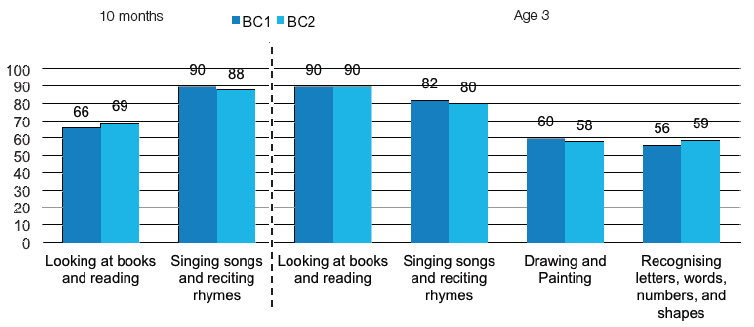
Unweighted bases: Base sizes varied slightly for each item. Lowest base sizes: 10 months: BC1: n=5215, BC2: n=6126; Age 3: BC1: n=4184, BC2: n=5000.
When looking at the overall frequency of activities children had engaged in in the last week (measured as the total number of days children had done each of the four activities), more than eight out of ten children, in both cohorts, had undertaken frequent activities [16] - 82% in BC1 and 83% in BC2. There was no statistically significant difference between the cohorts on this measure.
4.3.3 Variation in doing frequent activities by socio-economic circumstances
Previous analyses of BC1 data have shown that socio-economic circumstances, particularly parental level of education were some of the strongest factors associated with the frequency of home learning activities in the early years ( e.g. Bradshaw, 2011; Bromley and Cunningham-Burley, 2011). Children living in more advantaged circumstances were more likely to do activities most days than children living in less advantaged circumstances. By comparing the patterns in frequent activities by socio-economic characteristics for BC2 it is possible to see whether the nature of the relationship changed and, in particular, whether the gap between the most and least advantaged children reduced between 2007/08 and 2013.
The analysis showed that differences in doing frequent activities by socio-economic characteristics for BC2 children were similar to those for BC1 children. In relation to looking at books and reading at 10 months, as well as for each of the measured activites at age 3, differences by socio-economic characteristics (parental level of education, household income, and area deprivation) showed no significant change. [17] For singing songs at 10 months, the relationship between parental education and frequency of singing appeared to be stronger in BC2 than in BC1. That is, when looking at the proportion of children singing songs and reciting nursery rhymes most days, there was a larger gap between those with highly educated parents and those whose parents had lower level or no qualifications in BC2 compared with BC1. However, by age 3 this difference in variation by education was no longer significant.
Figure 4‑B illustrates how, for both cohorts, frequency of activities at age 3 varied by parental level of education. [18] The number of days reported for each activity - reading or looking at books, singing songs or reciting rhymes, drawing or painting, or playing at recognising letters, words, numbers or shapes - were counted separately and then added together. Thus for each child possible scores range from 0 (the child had not done any of the four activities in the last week) to 28 (the child had done all four activities every day in the last week). The graph gives the average scores for children in each education sub-group.
Figure 4‑B Doing frequent activities at age 3, by parental education (mean score)
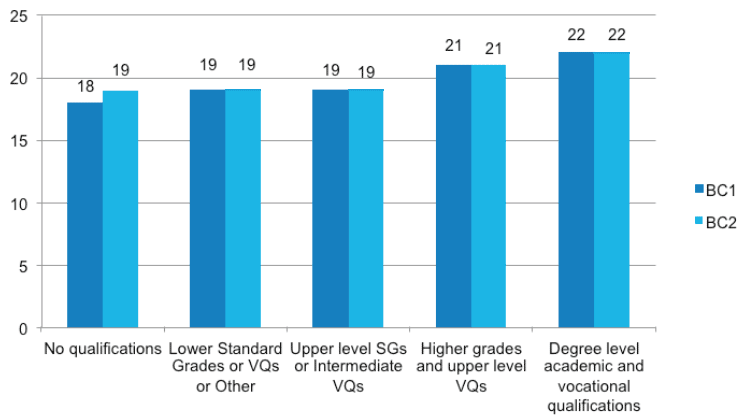
Unweighted bases: BC1: n=4182, BC2: n=4989.
Although Figure 4‑B shows an increase in doing frequent activities amongst children living in families where the parent or parents had no formal educational qualifications, this change was not statistically significant and the overall relationship between parental level of education and doing frequent activities at age 3 did not differ between the cohorts. In other words, the analysis found no statistically significant evidence of any 'narrowing of the gap' in relation to the frequency of activities undertaken at age 3.
4.4 Changes in frequency of reading between 10 months and age 3
Of particular interest in relation to reading and sharing books with children from an early age is the extent to which parents who did not read frequently with their child at 10 months may be encouraged to read more with their child as he or she gets older. Because frequency of looking at books and reading with the child was measured at both 10 months and 3 years for both cohorts, GUS data provides a possibility for assessing any increase in frequency of reading between these two age points and comparing this across the two cohorts.
- Answer categories differed across the two age points. Therefore, for the purposes of measuring a change in reading frequency, the following categories have been derived:
- 'Most days' (corresponding to 'Every day/most days' at 10 months and the child having looked at books on four to seven days in the last week at age 3)
- 'Less often but at least once a week' (corresponding to 'Once or twice a week' at 10 months and one to three days in the last week at age 3)
- 'Less often than once a week' (corresponding to all answers indicating the child looking at books less than once a week at 10 months, and the child not having looked at books in the last week at age 3 ( i.e. a score of 0)
Amongst parents who read to their child less often than 'most days' at 10 months, almost nine out of ten had increased the number of days they read with their child by the time the child was aged 3. This increase may reflect more parents being aware of the benefits of sharing stories and reading with toddlers, as opposed to babies, and therefore being more likely to participate in the activity when their children reach the later stage. However, it may also reflect that reading with children at age 3 is more widely understood as 'expected' behaviour for parents, possibly causing some parents to exaggerate their responses. As such, responses at age 3 may be more susceptible to bias with parents potentially more likely to report doing more frequent reading activities with their child than was actually the case.
Figure 4‑C shows the change in reading frequency between the two age points amongst those who looked at books or read stories with their child less often than 'most days' when the child was 10 months old.
Figure 4‑C Change in frequency of reading between 10 months and age 3 (%)
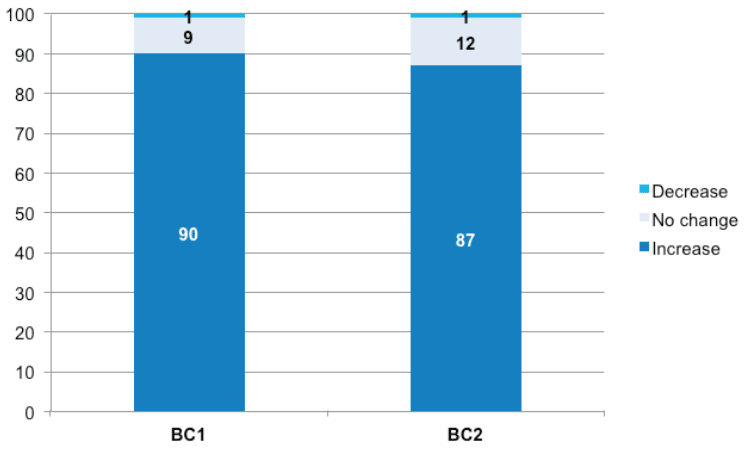
Unweighted bases: Respondents who read with their child twice a week or less when the child was aged 10 months: BC1: n=1322, BC2: n=1449.
As Figure 4‑C illustrates, amongst parents who read to their child less frequently than most days at 10 months, those in BC2 (87%) were slightly less likely to increase their frequency of reading than parents in BC1 (90%). This difference between the cohorts was even more pronounced when looking solely at those with the lowest levels of education [19] - amongst this group only 39% of parents in BC2 increased the frequency of reading with their child, compared with 46% of parents in BC1. However, when controlling for other factors which differed between the cohorts, including parental level of education, differences in the change in frequency of reading between 10 months and 3 years between the cohorts were no longer significant. [20]
4.4.1 Variation in change in reading by socio-economic circumstances
Section 4.3.3 above set out how frequency of doing activities at a single age point varied by socio-economic circumstances. A similar pattern was evident for increases in the frequency of reading from age 10 months to 3 years: parents living in more advantaged circumstances were more likely to increase their frequency of reading with the child. Figure 4‑D shows the proportion of parents in each education sub-group who reported an increase in reading frequency. It shows that the relationship between parental level of education and change in reading frequency was similar across the two cohorts, and that the increase in frequency of reading was lower in BC2 than in BC1 across all sub-groups of parental education.
Figure 4‑D % of parents who increased frequency of reading with child between 10 months and age 3, by parental level of education
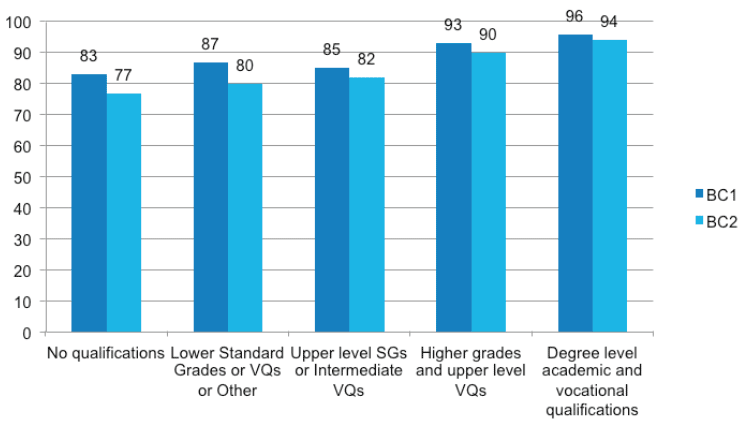
Unweighted bases: Respondents who read with their child twice a week or less when the child was aged 10 months: BC1: n=1322, BC2: n=1449.
4.5 Who children did activities with at age 3
As part of the GUS age 3 interview, parents were asked who the child did activities with. Across all four activities, the vast majority of children did activities with their mother. For example, of children who had looked at books or read stories in the last week at age 3, almost all (93% in both cohorts) had done this with their mother, while two thirds had done so with their father (67% in BC1, 66% in BC2). BC2 children were more likely than BC1 children to also look at books by themselves (76% in BC2 compared with 68% in BC1).
Across all four activities, the proportion of children doing activities by themselves has increased between the cohorts. The proportion doing activities with their mother had also increased for drawing and painting, and for playing at recognising letters, words, numbers or shapes. It is also worth noting that the proportion doing activities with their father had increased for all activities except for looking at books and reading stories (where no difference between the cohorts was found).
Further analysis was undertaken to explore factors associated with fathers participating in all four activities ( i.e. reading or looking at books; singing songs or reciting nursery rhymes; drawing or painting and playing at recognising letters, words, numbers or shapes). [21] This showed that main carer's partners (in most cases the child's father) who worked part-time were more likely to engage in all four activities with their child than those who worked full-time. As noted elsewhere (see Bradshaw, Knudsen and Mabelis, 2015), fathers in BC2 were slightly less likely than fathers in BC1 to work full-time. This may suggest that changes in fathers' employment patterns between cohorts contributed to the increase in children who did all four activities with their father.
A number of other factors were also independently associated with fathers taking part in all four activities, which suggests a more complex explanation than just simply changes in employment patterns. [22] Notably, even after controlling for a range of variables known to influence the frequency of home learning activities, children in BC2 were still more likely to do all four activities with their father than children in BC1. Altogether, this suggests that there has been an increase in the number of activities 3-year-old children undertake with their father which cannot simply be explained by changes in employment patterns. This opens up an array of further questions related to fathers' engagement in early home learning activities which are beyond the scope of this report.
Figure 4‑E shows the proportion of children in each cohort who did all four activities by themselves, with their mother, with their father, or with someone else.
Figure 4‑E % of children doing all four activities with person
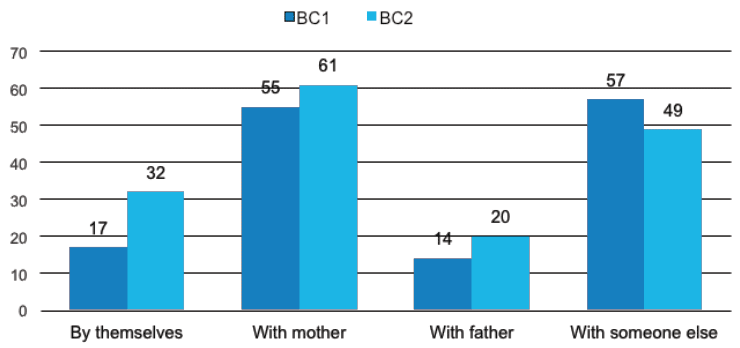
Unweighted bases: children who did all four activities in the last week. BC1 - N = 3457, BC2 - N = 4227
4.6 Relationship between early activities and vocabulary at age 3
Previous analyses of GUS BC1 data found associations between early parent-child activities and early language development (Bradshaw, 2011; Bromley and Cunningham-Burley, 2009). This section considers the relationship, for both cohorts, between frequency of parent-child activities (at both 10 months and age 3) and expressive vocabulary ability at age 3. In particular, it considers whether this relationship changed between the cohorts.
To explore whether frequency of reading at 10 months and children's level of home learning activities at age 3 were associated with vocabulary, these factors were added to the model alongside other factors known to be associated with vocabulary at age 3, namely employment status of main carer and family type. [23]
The results show that for both cohorts, frequency of reading at 10 months and frequency of doing non-reading activities at age 3 were independently associated with children's expressive vocabulary at age 3, after controlling for differences in socio-economic and other factors. Children who looked at books or read stories most days at 10 months had better vocabulary than those who were read to less often at 10 months. Similarly, doing more frequent activities at age 3 was associated with higher vocabulary scores. No evidence was found to suggest that the association between parent-child activities and vocabulary ability had changed between cohorts. [24]
Further analysis suggested there was no difference in the relationship between doing frequent activities and vocabulary score according to parental education in either of the cohorts. [25] Thus the positive relationship between participating in frequent home learning activities and increased vocabulary scores applied equally to children whose parents had high levels of education and those who had no formal qualifications - in line with findings from previous analysis on GUS (see e.g. Bradshaw, 2011). This relationship persisted in both cohorts.
Contact
There is a problem
Thanks for your feedback